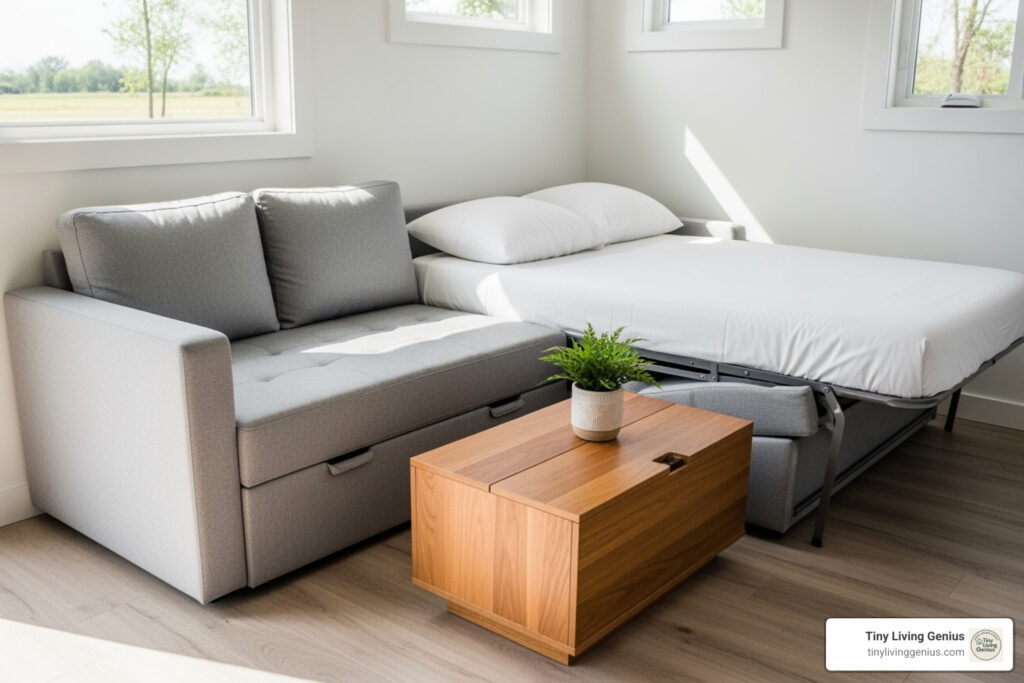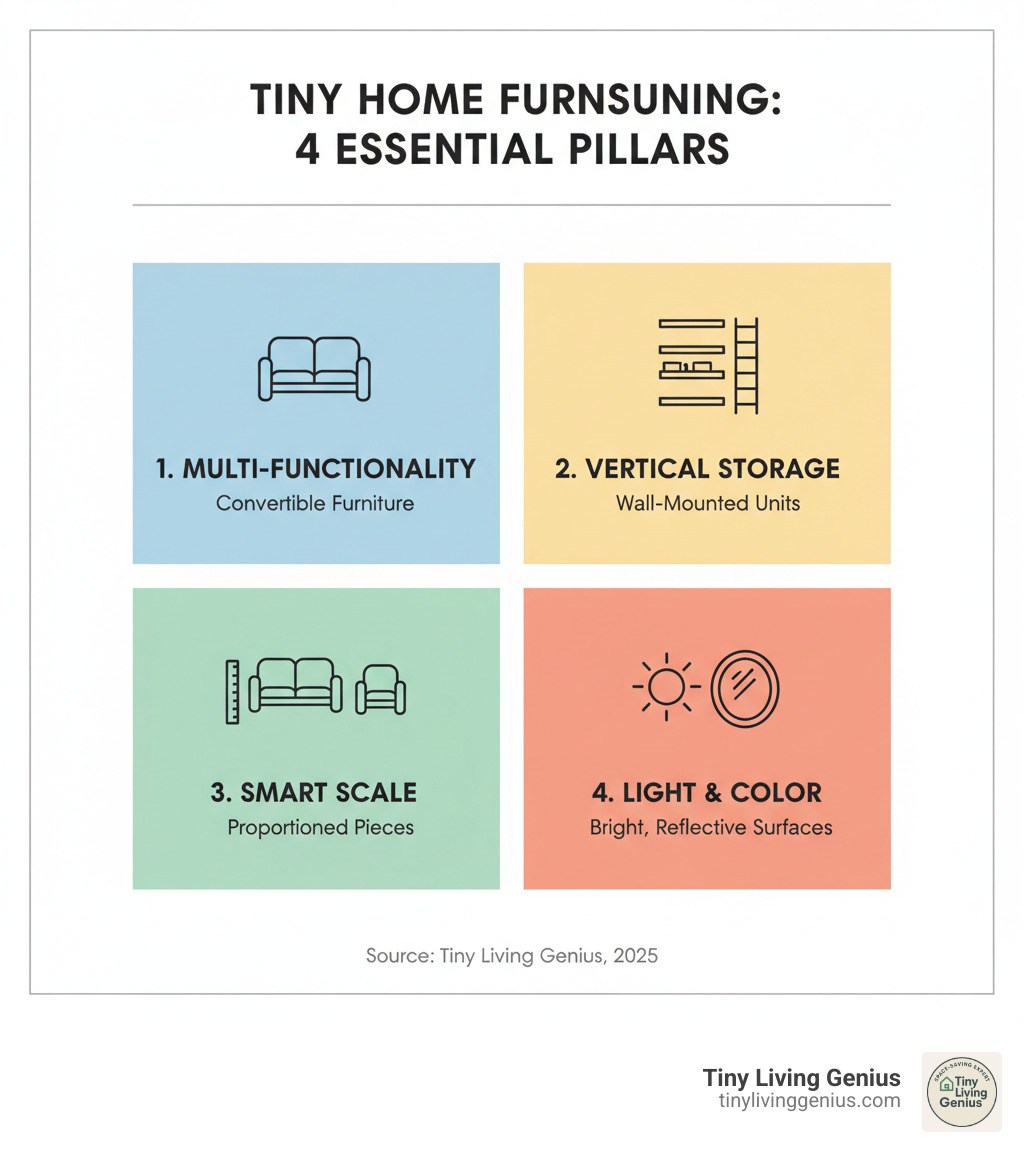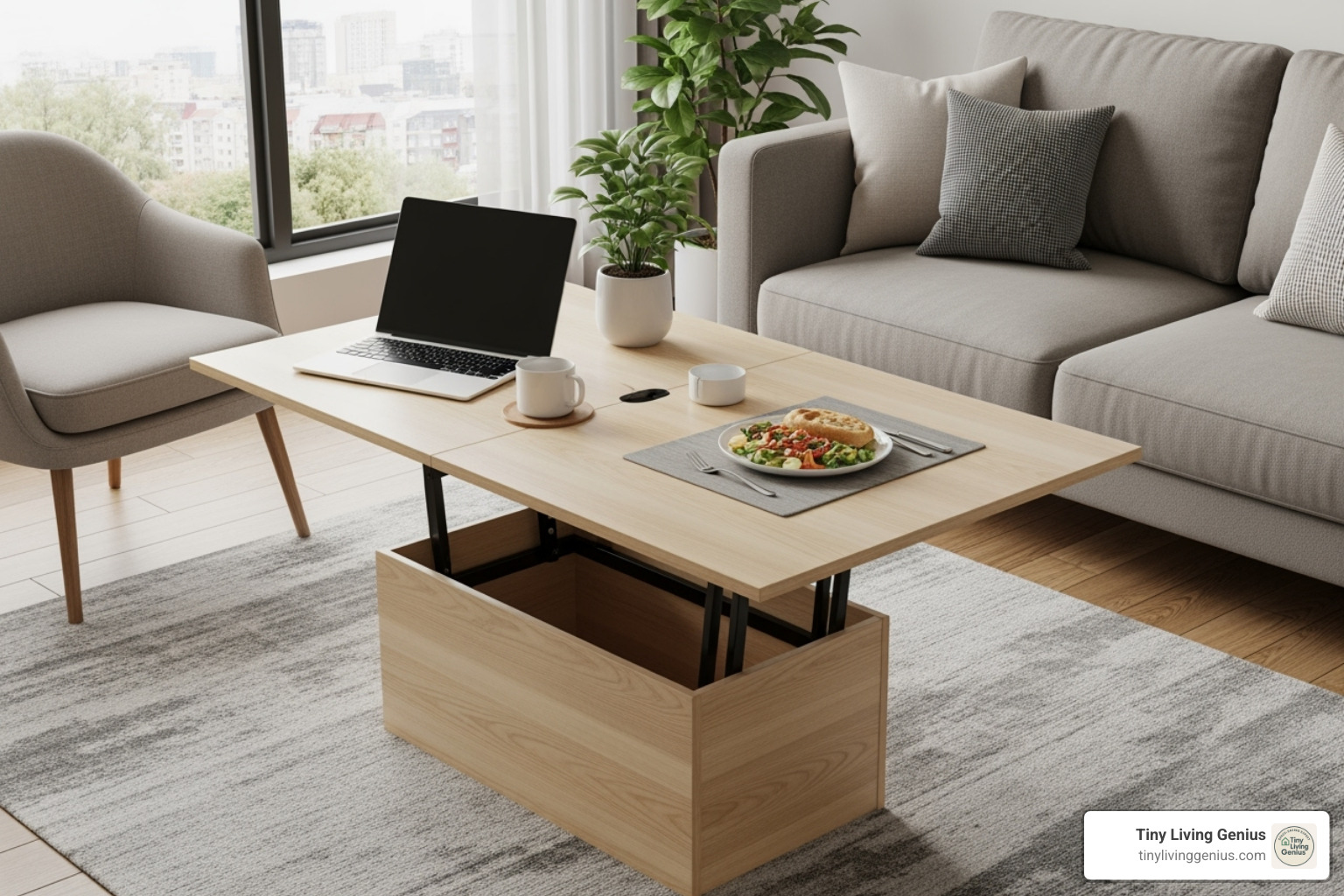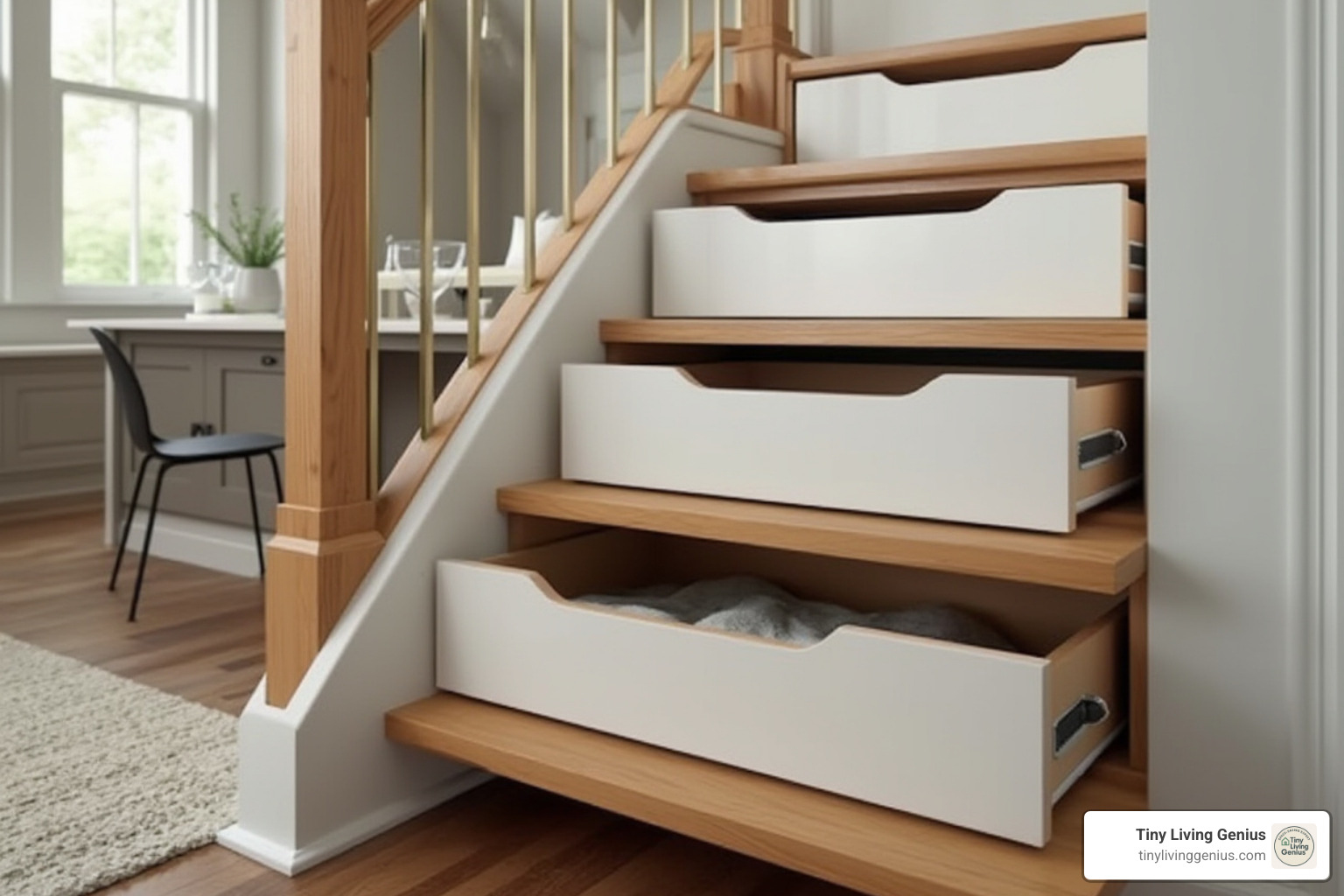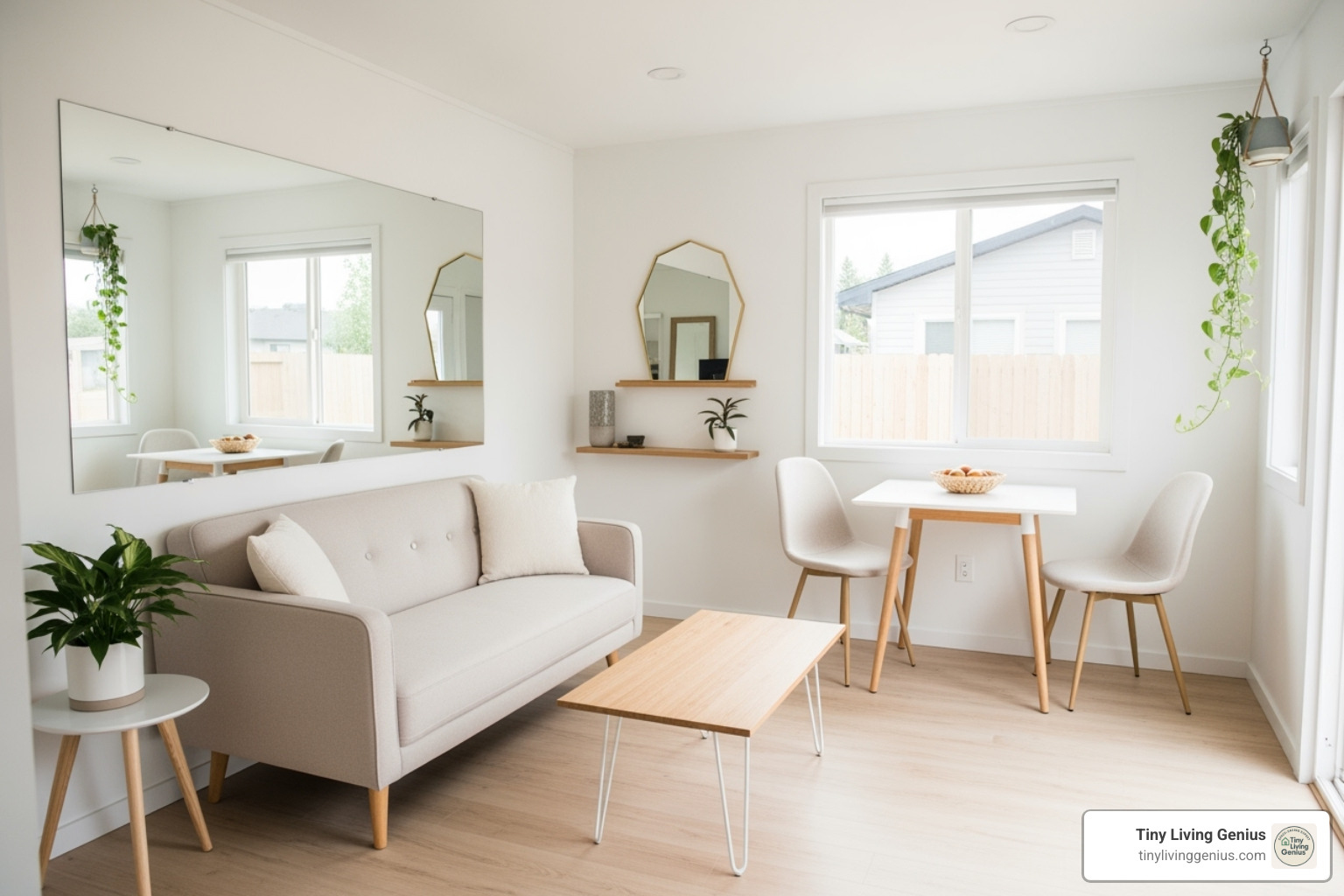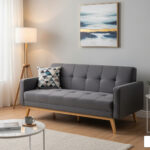Tiny home furniture: 4 Best Innovative Solutions
Why Tiny Home Furniture Makes or Breaks Your Living Experience
Tiny home furniture isn’t just about finding pieces that fit; it’s about creating a functional, comfortable living space where every inch serves a purpose. Whether in a 400-square-foot tiny house or a compact studio, the right furniture can transform a cramped space into an organized, stylish home.
The best tiny home furniture must deliver on four key requirements:
- Multi-functionality – Each piece serves 2-3 purposes (sofa that becomes a bed, coffee table with storage)
- Smart scale – Properly sized for small spaces without overwhelming the room
- Vertical storage – Takes advantage of wall space and height for organization
- Light design – Uses materials and colors that make spaces feel larger and brighter
Moving into a tiny house requires drastic downsizing. The challenge isn’t just fitting everything in; it’s choosing furniture that maximizes usable space while maintaining comfort. As one tiny home expert notes, “Functionality is key: In a tiny house, every square inch and hidden space must serve a purpose.”
The environmental impact of thoughtful tiny living is also remarkable. With a minimized footprint and efficient use of resources, tiny homes with smart, multi-purpose pieces exemplify sustainable living.
I’m Ramy Saber, a Civil Engineer and founder of Tiny Living Genius. I combine technical expertise with creative problem-solving to help people maximize comfort in compact spaces. After years of testing tiny home furniture, I’ve learned the right pieces can make any small home feel spacious and organized.
The Core Challenges of Furnishing a Tiny Home
Furnishing a tiny home is like solving a three-dimensional puzzle where every piece must be perfect. I’ve helped countless tiny home dwellers steer these challenges, and while rewarding, it’s not without its problems.
The biggest reality check is the limited square footage. According to the International Residential Code, tiny homes are officially defined as dwelling units with a maximum of 37 square meters (less than 400 square feet) of floor area, excluding lofts. To put that in perspective, many living rooms are bigger than an entire tiny home! Every square inch is precious real estate.
Even trickier, awkward layouts are practically guaranteed. Tiny homes often feature irregular shapes, nooks, and slanted walls, making it hard to create distinct “zones.” That beautiful sectional sofa you found online probably won’t fit under a loft overhang.
For a THOW (tiny home on wheels), weight restrictions add another layer of complexity. Every pound matters for towing safety, so you must consider the weight of that solid wood dining table, not just its size and function.
Perhaps the most emotionally challenging aspect is the downsizing dilemma. Most people reduce their belongings by 70-80%. This isn’t just about getting rid of stuff; it’s about fundamentally changing how you view possessions and space.
This intense downsizing creates a need for dual-purpose items. In a tiny home, a single-function item must be essential. Your coffee table needs storage, your sofa should become a guest bed, and your dining table might double as your home office.
The good news is these challenges have sparked incredible innovation in tiny home furniture design. Understanding these constraints helps you turn limitations into opportunities.
For more detailed strategies on navigating these decisions, check out our comprehensive guide: How to Choose the Right Furniture for Your Small Space: A Comprehensive Guide.
The Magic of Multi-Functional Tiny Home Furniture
When I started exploring tiny living, I realized regular furniture wouldn’t work. Multi-purpose tiny home furniture isn’t just smart—it’s essential. With only 400 square feet, every piece must earn its spot by doing more than one job.
Functionality is key in tiny homes. A coffee table that only holds coffee is a luxury we can’t afford. But one that lifts to become a dining surface and stores your laptop? That’s a game-changer.
The space-saving benefits are obvious, but the magic goes deeper. Multi-functional pieces offer incredible cost-effectiveness—one smart piece can do the job of three. Plus, fewer items mean less money spent and less clutter.
I love the versatility these pieces bring. Your living room can transform into a dining room, then a workspace, and finally a guest bedroom. It’s like having a shape-shifting home that adapts to your needs.
This approach creates transformable zones within your tiny space. Without permanent walls, multi-functional furniture helps define different areas for various activities, allowing you to host a dinner party and then quickly rearrange for movie night.
For more innovative approaches to making your compact space work harder, check out our guide on Creative Furniture Solutions for Small Spaces.
Living Area Transformers
Your living area is the heart of your tiny home and needs to wear many hats. This is where smart tiny home furniture really shines.
Convertible sofas today are far from the uncomfortable sofa beds of the past. They are sleek, comfortable in both couch and bed mode, and many include hidden storage underneath for bedding. The best ones transform smoothly without needing to be moved.
Lift-top coffee tables are absolute game-changers. You can work on your laptop from the sofa with the table raised to the perfect height. When work’s done, lower it back down. Many feature hidden compartments that swallow up remotes and other clutter.
Nesting tables are like magic for small spaces. They stack neatly together, but when friends visit, you can pull them apart to create multiple surfaces for drinks and snacks. It’s flexibility without the bulk.
Storage ottomans are workhorses. They provide extra seating, a footrest, and hide away blankets or books. Some have reversible tops that create a stable tray surface. They’re the Swiss Army knife of tiny home furniture.
If you’re ready to dive deeper into optimizing your main living space, our Top 7 Foldable Sofas for Small Living Rooms and The Ultimate Guide to Living Room Furniture Sets: Smart Design for Every Space offer detailed guidance.
Smart Sleep & Work Sanctuaries
In tiny homes, the lines between sleeping, working, and living blur. The secret is choosing tiny home furniture that creates distinct zones without eating up precious square footage.
Murphy-style beds (also known as a Murphy bed) are ultimate space-savers, folding vertically into a wall unit to free up floor space. Modern versions often include built-in desks, shelving, or storage, creating a home office by day that transforms into a bedroom by night.
Loft beds brilliantly take advantage of vertical space. A sturdy adult loft bed creates a dedicated sleeping area while leaving the space below free for living, working, or storage. For families, bunk beds are lifesavers, especially versions with integrated storage.
Daybeds with trundles are a great middle ground. They work as sofas during the day and expand into comfortable sleeping areas at night. The trundle feature is genius for guests, providing an extra bed that disappears when not needed.
Wall-mounted folding desks are essential for working from home. Pull down your desk to create a proper workspace, and when you’re done, fold it flat against the wall where it practically disappears. Some designs even include two levels for extra surface area.
For more detailed information on creating the perfect sleep and work spaces, explore our guides on 10 Best Space-Saving Beds with Storage for Small Apartments and Wall-Mounted Desks: Smart Solutions for Space-Saving Workstations.
Creative Storage: Thinking Inside and Outside the Box
In tiny homes, storage isn’t just about stashing stuff; it’s about making every inch work harder. With limited square footage, creative storage is the difference between a cramped, chaotic home and one that feels spacious and serene.
The secret lies in vertical storage solutions that draw the eye upward, making rooms feel taller. Think beyond floor-based storage and see walls, corners, and even ceilings as valuable real estate. Hidden compartments are another game-changer, seamlessly integrating storage into furniture and architecture.
One of our favorite innovations is under-stair solutions. The space beneath your loft stairs is prime storage territory, perfect for deep drawers or a complete pantry. Modular storage chests add flexibility, letting you stack and rearrange your storage as needs change.
The beauty of creative storage is that it’s often invisible until needed. When everything has a cleverly concealed place, your tiny home maintains a clean, minimalist aesthetic. For more comprehensive strategies, our Smart Storage Solutions for Small Spaces guide dives deeper.
Utilizing Every Nook with Tiny Home Furniture
In tiny living, no corner is too small or wall too narrow to be useful. The key is to see potential storage everywhere.
Corner shelving units are perfect for turning awkward angles into functional display areas for plants, books, or decor, using space that would otherwise be wasted.
Over-the-toilet units are brilliant for tiny bathrooms. These tall, narrow cabinets provide essential storage for toiletries and towels without using precious floor space, solving a common storage afterthought in tiny homes.
Wall-mounted cabinets can hold everything from kitchen supplies to bathroom essentials, keeping items accessible while maintaining clean sight lines. A shallow unit could store spices while displaying favorite dishes.
Don’t forget door-mounted storage! The back of every door is valuable real estate for hooks or full organizers, keeping frequently used items handy without cluttering your main living areas.
For detailed strategies on making the most of your vertical space, check out our guide to Maximize Vertical Space in Small Spaces.
The Best Tiny Home Furniture for Integrated Storage
The neatest tiny home furniture pieces are those with seamlessly integrated storage. They are designed from the ground up to be both beautiful and functional.
Storage benches exemplify this philosophy. A beautiful bench at the foot of your bed can be a focal point while storing extra blankets or shoes. It’s seating, storage, and style in one.
Beds with built-in drawers transform the wasted space under your mattress into a clothing storage powerhouse. These platform beds provide deep drawers that can hold everything from daily wear to bulky sweaters. Our Bed Frames with Storage: Maximize Space Without Compromising Style guide explores these options.
Ottomans with hidden space are incredibly versatile. They’re footrests, extra seating, and secret storage for small items. Some even have reversible tops that become serving trays.
Sofas with under-seat storage are another brilliant innovation. Many sectionals feature lift-up chaise sections revealing spacious compartments, perfect for storing extra bedding or off-season clothing while keeping your living room looking magazine-ready.
Design Tricks to Make Your Tiny Home Feel Huge
Tiny homes don’t have to feel tiny. With the right design tricks and smart tiny home furniture, you can create an illusion of spaciousness that will surprise your visitors.
The secret lies in understanding how our eyes perceive space. Embracing minimalist design principles—clean lines, uncluttered surfaces—gives rooms permission to breathe. A space feels much larger when every item has its place.
Color psychology plays a huge role. Light paint colors like whites, soft grays, and warm beiges are proven space-expanders. They reflect light, creating an airy feeling. A neutral base also allows for colorful accents without overwhelming the space.
Strategic lighting helps you live big. Maximize every ray of natural light. After sunset, well-placed artificial lighting continues the magic. A clever floor-lamp and end-table combo provides both illumination and surface space without bulk.
Our favorite trick is using mirrors. These reflective wonders are like a magic wand for small spaces. A mirrored console table, for example, doubles the visual impact of light and space. Strategically placed mirrors create depth and expand the room’s perceived boundaries, adding ‘square footage’ without construction.
For more insights on maximizing brightness, our guide on Natural Light in Small Spaces offers practical tips.
Choosing the Right Style and Materials
The materials and styles of our tiny home furniture can make a space feel larger or smaller. It’s about what makes your space feel good.
Light-colored furniture works with light wall colors. When furniture blends with the room’s palette, it becomes part of the background rather than a visual obstacle. Avoid dark, heavy pieces that can make a room feel cramped.
A designer secret: furniture with visible legs is gold in tiny spaces. Seeing the floor underneath a sofa or table makes our brain perceive more open space, creating an incredible sense of openness.
For an even more ‘invisible’ approach, clear acrylic furniture offers functionality without adding visual weight. Acrylic chairs and tables are perfect for a modern, minimalist aesthetic.
Let’s not forget sustainability. Bamboo furniture brings warmth and is incredibly eco-friendly. Reclaimed wood pieces tell a story and give new life to existing materials, aligning with the reduce-and-reuse philosophy of tiny living.
When we choose reclaimed items and eco-friendly materials, we’re making choices that reflect the values that drew us to tiny living.
For more inspiration, explore our insights on Modern Furniture Designs Maximizing Small Spaces. And don’t forget to extend your living space outdoors with our 10 Space-Saving Tiny Balcony Ideas for Apartments.
Frequently Asked Questions about Furnishing a Tiny Home
After years of helping people with compact living, we’ve noticed the same questions pop up. Here are the answers to the most common concerns.
What is the best furniture for a tiny house?
The best tiny home furniture is multi-functional. Every piece should do more than one job, like sofa beds that create a guest room, or lift-top coffee tables that double as desks. Also, look for scalable furniture with slim profiles designed for smaller footprints. For tiny homes on wheels (THOWs), lightweight items are crucial for towing safety. While expensive, custom-built solutions can offer a perfect fit for awkward spaces.
How do you fit a couch in a tiny house?
Fitting a couch is a common puzzle, but it’s doable. Start with apartment-sized sofas, which have smaller dimensions and slimmer arms. Modular sectionals offer flexibility to fit your exact layout. Convertible futons or sofa beds are brilliant for dual-purpose areas. For smaller needs, loveseats or armless chairs provide seating without the bulk. The best couch will be comfortable, easy to clean, and serve more than one purpose, like offering storage or a guest bed.
Should I get custom-built furniture for my tiny home?
This depends on your budget, timeline, and space. Custom furniture is ideal for awkward spaces—like slanted walls or low ceilings—where standard pieces won’t fit, maximizing functionality. You also get features custom to your lifestyle. However, custom pieces cost more and have longer lead times. Our advice: use custom work strategically for the most challenging spots. You can create a beautiful, functional home with mostly retail tiny home furniture and a few key custom elements.
Conclusion
We’ve explored how furnishing a small space isn’t about making do with less—it’s about choosing better tiny home furniture. From cramped corners to clever solutions, the journey is about smart choices.
The magic happens when we accept multi-functionality. Every storage ottoman that doubles as seating and every Murphy bed that disappears by day proves that smart furniture can multiply our living possibilities. Smart storage isn’t just about hiding things; it’s about creating systems that make daily life smoother.
Those clever design tricks we explored—light colors, mirrors, and leggy furniture—are the secret ingredients that transform a tiny house from cramped to cozy and spacious.
We’ve seen how sustainable materials like bamboo and reclaimed wood align with the eco-conscious heart of tiny living. Choosing multi-purpose furniture saves space and honors our planet.
At Tiny Living Genius, we believe your compact space should work as hard as you do. Whether you’re dealing with awkward layouts or weight restrictions, the right furniture solutions can transform your tiny home into something extraordinary.
Living tiny is about living with intention and creativity. Every square foot is an opportunity, and every furniture choice is a chance to prove that great things come in small packages.
Ready to turn your small space into a masterpiece of efficiency and style? Explore our complete guide to space-saving furniture and find even more ways to make every inch of your tiny home work beautifully for you.

